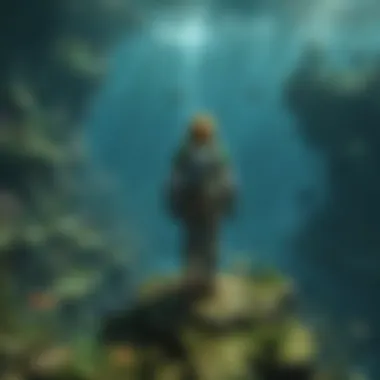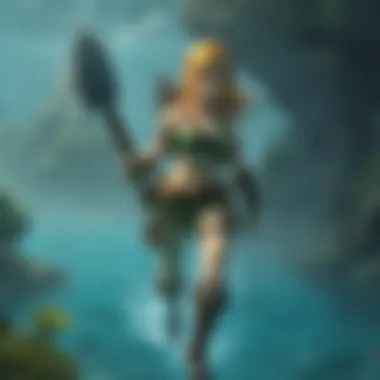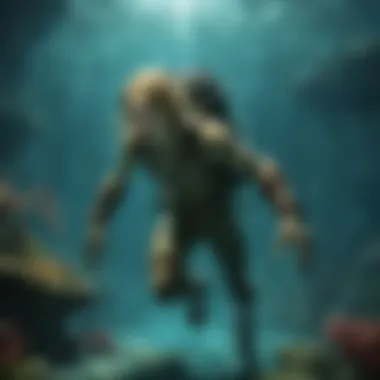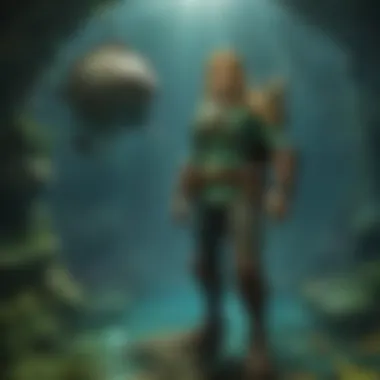Master Divers: Exploring Zelda's Aquatic Adventures


Intro
Diving into the world of Zelda, one cannot help but notice the critical role that aquatic environments play within the series. Whether it's gliding through water in Ocarina of Time or exploring the depths in Breath of the Wild, mastering diving mechanics is crucial for enjoyment and exploration across titles. This article reflects on the evolution of diverse aquatic gameplay and how master divers, in particular, have shaped player experiences. Moreover, it examines the lore surrounding notable aquatic characters and their contribution to the broader narrative of Hyrule.
Game Reviews
Gameplay Features and Mechanics
The introduction of water-based mechanics became prominent with the series' first ventures into 3D. Ocarina of Time was revolutionary in how it utilized water. Gameplay mechanics, such as swimming, urged players to adapt their strategies to the fluid dynamics of Hyrule’s lakes and rivers. Each title generally builds upon the previous mechanics, refining diving movements and adding new tools such as the Zora Mask from Majora’s Mask. Over the years, swimming styles became more fluid, allowing players to perform various actions like diving and surface swimming that demand precise timing and awareness.
Storyline and Quests
Water-themed quests often reveal pivotal plot points. In Twilight Princess, players encounter watergardens that function as both temples and critical progress markers. Completion becomes a character's rite of passage as they navigate underwater challenges, combining quest elements with environmental storytelling.
Visuals and Sound Design
The design of aquatic environments in the Zelda series, especially in more recent entries, presents breathtaking visuals. The fluid surfaces and colorful marine life contribute to immersing players in the aquatic experience. Accompanied by serene soundscapes, especially defined in titles like Wind Waker, the ambience enriches excitement when exploring the oceanic depths. The sound of splashing water and the isolate quietness under the sea enhance player engagement significantly.
Comparison with Previous Titles
Masters of diving mechanics have continuously refined their skills across the games. From Link's Awakening with static waters and pixelated density to the intricate water gameplay in Breath of the Wild, the evolution emphasizes how developers meet player needs to enhance immersion.
“With each new title, there must be a dedication to evolve mechanics to ensure players remain as engaged under the sea as they are elsewhere.”
Character Analyses
Popular Characters Overview
Water-related characters play substantial roles within the Zelda universe, with prominent figures like Princess Zora or the iconic Bongo Bongo being effortless examples. Each character Entity enriches Hyrule’s lore.
Character Development and Backstories
The intriguing complexity of Zora’s lineage often captivates players, as individual background stories merge with the main quest line. These characters encapsulate the essence of coastal challenges, often revealing deeper facets of their societies, facilitating moral lessons about cooperation and respect for nature.
Role in the Zelda Universe
It’s necessary to reflect on their contributions across various games. Each character introduces new narrative possibilities, instilling emotional facilitating across surface and depth dilemmas in the adventures through Hyrule.
Fan Theories and Speculations
Fans often build theories on characters’ fates and unexplored histories in speculative narratives. For example, the origins of Blue Lizalfos offer engaging, yet essential deduction, adding richer experience while factoring in dive challenges that have surfaced in past entries.
Lore Discussions
Mythology and Worldbuilding
Emerging through the narrative complexities, players discover how legends intertwine mythically with water sections. Delving deeper into these creatures unlocks realms set away from the standard gameplay to shadows of Hyrule’s past.
Legendary Items and Artifacts
Items like the Iron Boots possess deep lore origins. The processes achieved using them German notions of hardship conceptualized in game mechanics.
Link to Real-world Mythologies
Drawing analogous parallels such as the revered Kami in Wennycled relates stories of deities derived from folklore, capturing essence between water culture and action present in Zelda.


Timeline Placement and Theories
Positioning water-themed entries in conjunction with the entire Zelda timeline leads opinions into myriad possibilities. Exploring games’ unique stories provokes discussion or consideration for major plot timeline inclusions connected to ocean or riveric entities present thru Hyrule’s vast legacy.
Gameplay Strategies
Combat Techniques and Tips
While navigating submerged regions, understanding enemy capabilities is elemental. Transitioning between surface fighting and immersing entails apt changes timing-based through selecting strategic armaments corresponding to EM♥❤️❤️
Puzzle Solutions and Walkthroughs
Many underwater realms contain whimsical puzzles that compel not only efficient duality of challenges themselves from combat to logical riddles — manner successfully link aquatic explorations.
Collectibles and Side Quest Guides
Collection includes submerged items transforming not only nightly grade gameplay loop, collecting identified root matter - post cultivated unlocking region confidence.
Boss Battles Tactics and Strategies
Confrontations embedded amid numerous aquamarine selections fluctuation vary from simple melee exchanges to intensity bifurcations invoking themes manifest in subtle comforts against foes bound in yielding charges.
Prolusion to Master Divers and Their Role in Zelda
Master divers play a crucial role in the Zelda franchise, especially in an aquatic context. They are not just characters, but embodiments of the supportive gameplay features that enhance the player's experience. In this section, we will explore the foundational concepts behind these master divers and provide historical insights on how aquatic gameplay has developed throughout the series.
Understanding the Concept of Master Divers
Master divers in Zelda typically refer to skilled characters, like Link, who navigate water-centric environments with agility and expertise. These characters often possess unique abilities related to swimming and diving, making them integral to solving environmental puzzles and achieving objectives.
One characteristic that marks master divers is their innovative use of equipment. Tools like the Zora Armor in The Legend of Zelda: Ocarina of Time or the Swimming Cap from The Legend of Zelda: Spirit Tracks enable characters to maneuver seamlessly through underwater settings. Such mechanics provide a more engaging layer of gameplay, compelling players to think strategically about resource management and navigation.
Diving expands the realm of exploration in Hyrule significantly. By incorporating various water-related skills, players encounter hidden treasures, quests, and secrets that would otherwise remain inaccessible. The concept speaks to the grand design philosophy of Zelda, emphasizing interaction and discovery in lush environments.
Historical Context of Aquatic Gameplay in Zelda
Aquatic challenges have been present almost since the inception of the Zelda series. Starting from The Legend of Zelda, where limited swimming abilities influenced gameplay decisions, the evolution of water mechanics has mirrored technological advancements in game design over the years.
In The Legend of Zelda: The Wind Waker, a vast ocean replaced traditional landlocked areas, emphasizing exploration over linear progression. The introduction of sailing changed how players interacted with water, paving the way for intricate quests tied to master diving. During this movement from island to island, Link’s experience expanded, showcasing how water mechanics enhanced the narrative depth.
By analyzing the historical foundations of these mechanics, one notices significant progressions. With each subsequent title, developers aimed to refine the underwater experience further and add layers of complexity to puzzles that regularly require a forensic understanding of fluid environments. From Ocarina of Time’s swimming-centric gameplay to the rich underwater atmospheres in Breath of the Wild, the franchise has exhibited continual growth in illustrating how water can shape an adventure.
Understanding these historical contexts not only shed light on the gaming evolution of Zelda but also invite players to appreciate the depth found within previous installments. As gameplay continues to evolve, recognizing these earlier motifs helps contextualize advancements toward future titles.
Evolution of Diving Mechanics in the Zelda Games
The evolution of diving mechanics within the Zelda franchise is pivotal, showcasing the sophistication and creativity that developers have injected into aquatic gameplay. Initially, diving was a rudimentary action, serving primarily to advance the story and connect players with cavernous aspects of Hyrule. However, as the series progressed, the complexities of these mechanics became more pronounced. This evolution resonates with both nostalgia and innovation, enriching the gaming experience and providing an increased sense of immersion.
From The Legend of Zelda to Breath of the Wild
Comparative Analysis of Diving Techniques
The comparison of diving techniques in various Zelda games reveals notable developments and gameplay shifts over the decades. Gameplay mechanics have transitioned from simple plunges into a body of water to intricate controls, enhancing both realism and engagement. Early on, players like Link would dive with minimal interaction, often leaning entirely on basic buttons to achieve their objectives. In contrast, more recent iterations demand precision and dexterity, creating a thrilling rift in skill requirement from title to title.
This progression highlights a key characteristic: the expansion of underwater exploration possibilities. For example, The Legend of Zelda: Ocarina of Time introduced new tactics with the Zora's escalade antics, bypassing one-dimensional physical mechanics of earlier games. This change is not only beneficial but also necessary, keeping players captivated by the varying challenges behind each dive.


The comparative complexities often come with mixed advantages. One might argue that the layer of depth provides excitement, yet others see it creating a potential barrier for casual players. New features necessitate time and practice, altering the learning curve significantly.
Technological Advancements in Game Design
Technological advancements have played a significant role in refining how players interact with water and diving activities in Zelda. With each new game, the visual fidelity, fluid dynamics, and physical interactions have achieved previously unthinkable standards. The improved graphic capabilities and robust programming allow developers to manifest aquatic environments that feel alive and responsive. Elements such as realistic water currents and reflections draw the player into an immersive experience.
A key characteristic worth noting is the complexity of animation and physics in aquatic settings. As seen in The Legend of Zelda: Breath of the Wild, Link’s access to different diving techniques showcases the wisdom behind advanced tech use; it juxtaposes freedom and environmental realism. While diving as a mechanic has adapted fluidly and intricately, creating relatable player experiences, there are challenges intertwined with advancements. Complex interfaces may elevate player experience, yet also introduce contortion if not grasped – maintaining accessible gameplay still stands vital.
Key Episodes Featuring Diving Challenges
Key signatures throughout the series leverage diving challenges, becoming memorable and requiring engagement. Individual games demonstrate varying ways to push player abilities underwater and construct a journey that interconnects the elements of skill, lore, and the essence of exploration in a water-rich universe.
The Significance of Water-Based Environments
Water-based environments in the Zelda franchise represent more than just exploratory areas. They are intricately designed landscapes that combine lore, gameplay challenges, and immersive narratives. These aquatic settings contribute to both the gameplay mechanics and the storytelling, creating a unique experience for players.
Through the diversions in water realms, players engage in various encounters that test their skills and knowledge. Special mechanics arise, pushing the players to adapt their strategies. This interaction is crucial in cementing the franchise's immersive qualities.
Exploring the Lore of Aquatic Realms
Each water segment in the Zelda series contains rich narratives that contribute to a player's understanding of Hyrule's history. Locations such as Zora’s Domain are steeped in the culture of water-dwelling creatures and featured prominently in several titles. These locations help shape the world, pushing the player to think differently about aquatics—beyond just surfaces.
The intricate backstories of the Zora and their deep connections with water examine themes of sacrifice, loyalty, and coexistence in both land and sea. How about when Zelda and Link interact with the Zora? Their connections surprise many and few forget them easily. This engagement often unveils deeper layers of gameplay challenges as players delve into Zora lore.
Impact of Water Mechanics on Gameplay
Fluid Dynamics in Game Worlds
Fluid dynamics software in game design greatly improves realism in aquatic settings. Promoting immersive experiences helps players understand depth and other waterways better. This dynamic also allows physical interactions with the water as characters surface or dive, changing their speed or visibility.
These dynamics boost ina and how one understands game design. Valuable to the experience, players often acknowledge this distnict ottenticity. However, such realism can also generate challenges, particularly for new players.
Environmental Puzzles and Their Design
Environmental puzzles based on water mechanics play essential roles in the overall gameplay.What introduces more dimensions in solving vriddles is understanding currents, pressure, and how nearby objects can interact. Each puzzle distinguished through innovative manipulation of surroundings adds enrichment to challenging single-player quests. They generate great replay value while urging players to test their comprehension.
Benefits arise from how varying water levels increase complexity in puzzle-solving while managing resources effectively before diving. One main idea focuses on ensuring players engage actively while realizing thematic depth through every rise and fall. Connecting concepts creates strong gameplay resolutions while imparting crucial learning throughout journeys.
Master Divers as Characters within the Narrative
Master divers within the Zelda series represent more than just gameplay mechanics—they are integral to the narrative structure and lore of the universe. They deepen the connection players forge with the Hyrule world by offering relatable experiences and enriching character arcs. These characters embody a confidence in their skills, driving home themes of exploration and adventure. Their roles highlight the challenges and triumphs associated with aquatic environments, making them not merely side characters, but central to the overall story experience.
Notable Master Divers Throughout the Series
Link's Diving Adventures
Link's diving adventures are an essential part of the gameplay experience. These moments often require players to engage directly with underwater challenges. In games like The Legend of Zelda: Ocarina of Time, underwater exploration takes on various forms, from finding hidden treasures to solving intricate puzzles. The key characteristic of these diving missions is the need for problem-solving skills while managing the timelines and pressures of oxygen supply. This creates a sense of urgency and excitement that adds depth to the player's journey.
One unique feature of Link’s dives is their multifaceted nature—combining exploration, puzzle-solving, and combat. Engaging in these underwater activities yields not only rewards but also knowledge about the environment and its lore. This layered experience enhances the overall narrative by linking player actions to impactful story elements.
Supporting Characters and Their Contributions
Supporting characters in the Zelda series have made significant contributions to enhancing the role of master divers. Notable characters may include the various Zora, an aquatic race known for their swimming prowess. These characters characterize the relationship between the land and water, shedding light on a rich backstory and culture that resonates with players. What makes these supporting characters a favorable asset is their unique abilities that compliment Link. For instance, Zora's ability to facilitate water travel or offer crucial upgrades has fundamentally shaped Link’s effectiveness when navigating aquatic terrains.
A distinct feature of these characters is their ability to guide Link through both gameplay and lore insights. They help clarify the symbolism of water as a life force in the Zelda world, while also enriching face-to-face interactions with NPCs. These relationships enhance organic gameplay, creating a holistic environment where players feel part of Hyrule's narratives, leading on to more engaging encounters.


Cultural Symbolism of Water in Zelda Lore
Water in the Zelda universe conveys multilayered symbolism tied to life, growth, and transformation. Throughout various titles, water often enables the plot's key events. For example, in The Legend of Zelda: The Wind Waker, the vast ocean represents not merely difficulty in navigation but also the unknown stakes linked to freedom and discovery. The recurring theme of mastery over water aligns with character growth, illustrating that understanding nature leads to personal enlightenment and community harmony.
Through these representations, water is not merely present—it serves deeply intrinsic values, propelling character goals and influencing outcomes across the series. It impresses upon players the fundamental importance of embracing challenges and harnessing the wisdom achieved through unique experiences underwater.
Ultimately, master divers within the narrative operate at the nexus of gameplay mechanics and storytelling, showcasing that exploration extends beyond merely physical presence in the game.
Challenges Associated with Master Diving in Gameplay
The concept of master diving in the Zelda games introduces players to numerous challenges that enhance the gaming experience. These obstacles contribute to both the thrill of adventure and the strategic necessities within dive-centric environments. Understanding these challenges is essential for players, as it allows them to navigate the aquatic realms effectively. Master divers face unique tests relating to navigation and resource management that add complexity and depth to gameplay.
Navigational Obstacles
Currents and Their Effects
Currents in the water create unpredictable movements for players. They often push characters in any direction, altering their paths unexpectedly. This dynamic aspect serves as a crucial mechanic to keep players engaged. Players must anticipate these forces to plan their trajectories carefully when diving. The primary characteristic of currents is their ability to disrupt the straightforward approach many players might expect.
The currents promote an enhanced level of awareness and interaction. Players need not only to swim but to counteract these invisible forces, making decisions in real time. This interaction keeps the energy levels of floating gameplay prominent. However, a drawback is the potential for frustration, especially when current forces are not easily managed. Players sometimes find themselves trapped in loops, which may discourage casual exploration of underwater zones.
Limited Visibility Dynamics
Limited visibility underwater can significantly impact diving experiences. This factor heightens tension and mystery, enhancing the overall atmosphere of exploration in Zelda. The reduced visibility challenges players to navigate through murky waters, introducing a layer of surprise. Haunting shadows and fading edges even create more significant suspense, especially when encountering aquatic enemies or hidden treasures.
The challenge of visibility forces players to adapt their tactics. They must rely more on sound and environmental cues to progress rather than clear visual pathways. While this encourages intuitive exploration, limited visibility can lead to missteps or unexpected fatalities, making careful movement essential. Thus, maintaining balance between fear and exploration characterizes effective gameplay in these scenarios.
Resource Management Underwater
Oxygen Levels and Player Interaction
The aspect of oxygen levels introduces a survival component during dives. Players must constantly monitor their air supply, leading to strategic decision-making. Diving expeditions may then become timed efforts, where effective resource use leads to success. Because of dwindling oxygen supply, players approach underwater locales cautiously, planning their routes effectively. This risk reflects the strategic crunch players feel in intense survival situations, making it an effective addition to gameplay.
The unique interaction with oxygen dynamics creates an exciting push-pull relationship in exploration. However, inadequately managing these levels can result in frustrating failures, tarnishing what could have been moments of joy inside Hyrule's hidden depths. Hence, strategizing ways to obtain supplemental oxygen can turn into a thrilling mini-game itself, imbuing the diving experience with a sense of urgency and investment.
Impact of Resources on Strategy
Overall resource management critically shapes how players proceed in diving scenarios. When players accumulate treasures or useful items within the water, their approach to potential threats transforms. Especially within resource-rich areas, players find themselves contemplating if diving deeper will yield favorable rewards against stamina constraints. This push for easier planning cannot be overlooked.
Strategists who can prepare profusely usually translate these insights into decisive victories over obstacles below. Leveraging vast mail drops could also grant advantageous items that expand survival potential depth-wise. However, resource management also entails its drawbacks, with hesitation sometimes leading consumers to miss pivotal links on purification processes, thus resulting in subpar choices or lost opportunities.
In summary, navigating through challenges not only deepens immersion in gameplay. It encourages players to adapt and develop new strategies continually. Each facet encountered within diving, whether it is currents altering paths, shadows obscuring enemies, or resource management decisions, ultimately creates a stark awareness of the mysteries beneath the tranquil waves of Hyrule.
Culmination: The Integral Role of Master Divers in the Zelda Experience
Master divers serve as pivotal elements within the Zelda universe. Their functions extend beyond mere gameplay mechanics; they entwine with the rich narrative and lore of Hyrule.
In every installment, underwater exploration becomes central, offering players unique opportunities to engage with the environment. Master divers are not just characters; they contribute significantly to the intricate balance between game mechanics and storytelling. This relationship enhances immersion and helps shape player decisions, defining the overall experience. Their existence emphasizes the link between water gameplay and critical narrative arcs. Players witness growth not only in character skills but also in their understanding of the adventures within the vast oceanic territories.
Summarizing Insights on Aquatic Gameplay
Looking back at the evolution of aquatic gameplay, it is evident how diving mechanics have matured in the Zelda series. Each title often builds upon the last, refining controls and enhancing visual effects. This sophisticated progression has led to unparalleled levels of interaction. Master divers often introduce new challenges and experiences involving water, engaging players in not just a test of skill, but also a test of strategy. Elements like depth perception and environmental puzzles are vital, shifting the gameplay dynamic.
In particular, concepts such as fluid dynamics come into play, where the interaction between currents and visibility may dictate a player's approach. This aspect adds realism and complexity, making players more attuned to their surroundings. Players must constantly find solutions to resource management issues while navigating aquatic obstacles, creating more thrilling gameplay.
Future Prospects for Diving Mechanics in Upcoming Titles
Looking forward, expectations are high for future installments of the Zelda series. It seems reasonable to consider that developers might explore advanced diving mechanics inspired by modern technologies. Newer gaming systems can allow greater potential in graphic rendering and physics, crafting realistic underwater experiences. Indicator systems could emerge, fulfilling the gaps left by prior titles, enabling users to interpret underwater terrains easily.
Innovations in multiplayer dynamics may also reframe how players experience diving challenges. Integration of co-op missions would not only make the gameplay richer but would breathing new life into collaborative tasks. Experts hint at the possible inclusion of biomes uniquely suited to underwater experience challenges—those could redefine the role of water environments in the overarching narrative.
Thus, we find ourselves before an enticing future, balancing nostalgia for past mechanics and anticipation for an evolved diving experience for both long-time fans and new players. This ongoing evolution reflects an understanding of gameplay's importance and showcases how master divers will continue to shape the rich lore and experiences offered in future Zelda titles.
"Master divers are not mere game mechanics; they are an integral piece within Zelda, linking material challenges with deep storytelling."







